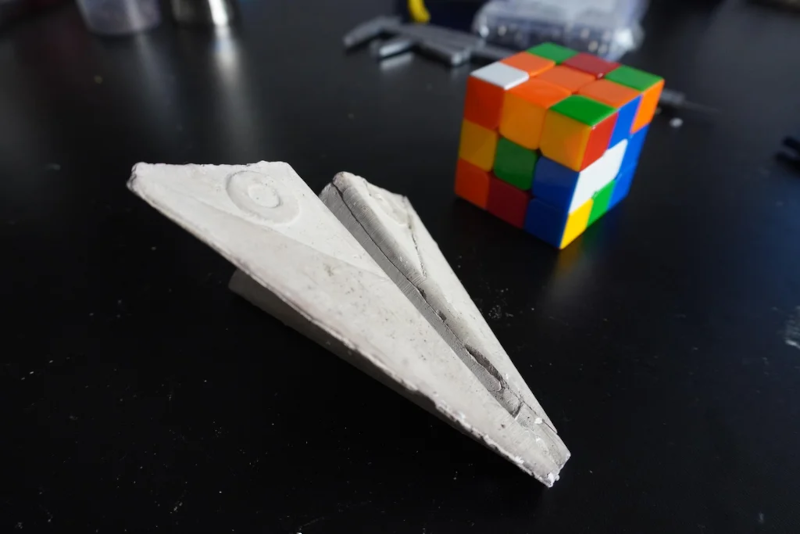Most of us have made paper airplanes at one time or another, but rather than stopping at folded paper, [VirgileC] graduated to 3D printing them out of PLA. Then the obvious question is: can you cast one in cement? The answer is yes, you can, but note that the question was not: can a cement plane fly? The answer to that is no, it can’t.
Of course, you could use this to model things other than non-flying airplanes. The key is using alginate, a natural polymer derived from brown seaweed, to form the mold. The first step was to suspend the PLA model in a flowerpot with the holes blocked. Next, the flowerpot gets filled with alginate.
After a bit, you can remove the PLA from the molding material by cutting it and then reinserting it into the flower pot. However, you don’t want it to dry out completely as it tends to deform. With some vibration, you can fill the entire cavity with cement.
The next day, it was possible to destroy the alginate mold and recover the cement object inside. However, the cement will still be somewhat wet, so you’ll want to let the part dry further.
Usually, we see people print the mold directly using flexible filament. If you don’t like airplanes, maybe that’s a sign.
















Some additional watching for cement planes can fly – if done correctly …
https://youtu.be/HU29bVFWNqo?si=jJvtONrUEd5l0PVm
Investigated ca 18 years ago in the mythbusters.
“can a cement plane fly? The answer to that is no, it can’t.”
At first they it sounded like quiet murmurings, then loud voices, but very soon it became obvious what every nerd on the planet was chanting in unison: CHALLENGE ACCEPTED.
Sure you can make a cement plane fly. It will glide about as well as the space shuttle though.
Everything glides, it is just a matter of descent rate, at some point we call it falling
That’s not flying, that’s falling….with style!
Unsure if a 1:1 glide ratio is flying, the space shuttle used a controlled descent for recovery.
Mythbusters already did it.
i mean it works on paper
Very underappreciated joke!
But only for spherical chickens in a vacuum.
A cement “paper” plane will have a glide ratio as good as a “proper” paper plane in a vacuum!
Obviously, this is just a problem of scale. Needs more plane.
I would say, it needs less plane. Volume is cubic, surface area is square. So the smaller you get, the easier it is to make something fly.
That, or add a jet engine, anything can fly with a big enough jet engine.
The word you’re looking for is ‘mould’; “mold” is that gross stuff that grows in damp buildings…
This is hilarious. Setting aside the fact that USians (and some Canadians) spell both forms of the word “mold”, users of Commonwealth English who still use “mould” use it in all of its various meanings. There is not the spelling distinction between the “organism” meaning and the “shaping object” meaning that you are alluding to. Unless you want to start one. I’d be for that. Add one for “kerb” and “curb” while you’re at it.
Curberos?
you can probibly come up with an exotic concrete that is light, perhaps carbon fiber rebar using pumice as aggregate.
You were on the Ekranoplan engineering team, weren’t you?
https://www.sefindia.org/forum/viewtopic.php?t=14227
That’s interesting. Raises the question: how much of the plane needs to be made of concrete for it to be a “concrete plane”? That looks like a foam plane with a skin of concrete to me, but it’s in the eye of the beholder, of course.
Concrete is a horrible material for planes, b/c it has great compressive strength and basically nothing else. Wings are the worst for concrete, because they’re all shear strength.
So maybe run truss rod / cables through the wings and tighten the living heck out of them?
They’ve become synonymous, but “concrete” doesn’t necessarily mean “Portland cement-based concrete”. Lots of things can be concreted together, and lots of things can be used to concrete said things together.
I don’t believe I’ve run across a common usage that doesn’t refer exclusively to the hard, heavy, portland cement based building material. Can you provide some concrete examples?
Stop being so hard headed and soften up a little!
If by concrete you mean a material that contains an aggregate which is bonded with cement, I give you plastic granules and PVC cement.
Desktop cement 3D printer?
You know what? That’s not the worst idea. As long as cement can be replaced with fine plaster of paris or white cement for high res parts.
How will it work? No idea! But I’ll buy it
as a ksp player, my rule is you can make anything fly if you add moar boosters.
Maxim 11. (Rephrased) : Everything flies through air at least once.
Old aphorism: bricks will fly if the engine has enough thrust. So will lawn mowers:
https://www.youtube.com/results?search_query=flying+lawnmower
Lead balloons can fly, witness this report of one being tracked across the Atlantic
httpshttps://adlittlechronicles.blogspot.com/2008/07/of-silk-purses-and-lead-balloons.html://adlittlechronicles.blogspot.com/2008/07/of-silk-purses-and-lead-balloons.html
Sigh. Lead balloon URL: https://adlittlechronicles.blogspot.com/2008/07/of-silk-purses-and-lead-balloons.html
air/athmosphere is a liquid, ocean is a liquid – it can fly, you need to choose proper liquid
The word you want is “fluid” not “liquid”.
I really wish they took a video of them throwing this off a balcony or something.
Anything with structural integrity can fly with the proper maintenance of forces. Anything.
define “fly”. Anything with a thrust to weight ratio greater than 1 could be propelled into the air ;) We can THROW anything and, depending on your definition of “fly”…. hahaha
Cement airplanes can fly, you just need to “mo powa bebe” it. Just ask integza. Pretty sure if you promise to destroy all tomatoes, he’ll help you.
I bet a papier-mache plane could be made to fly.